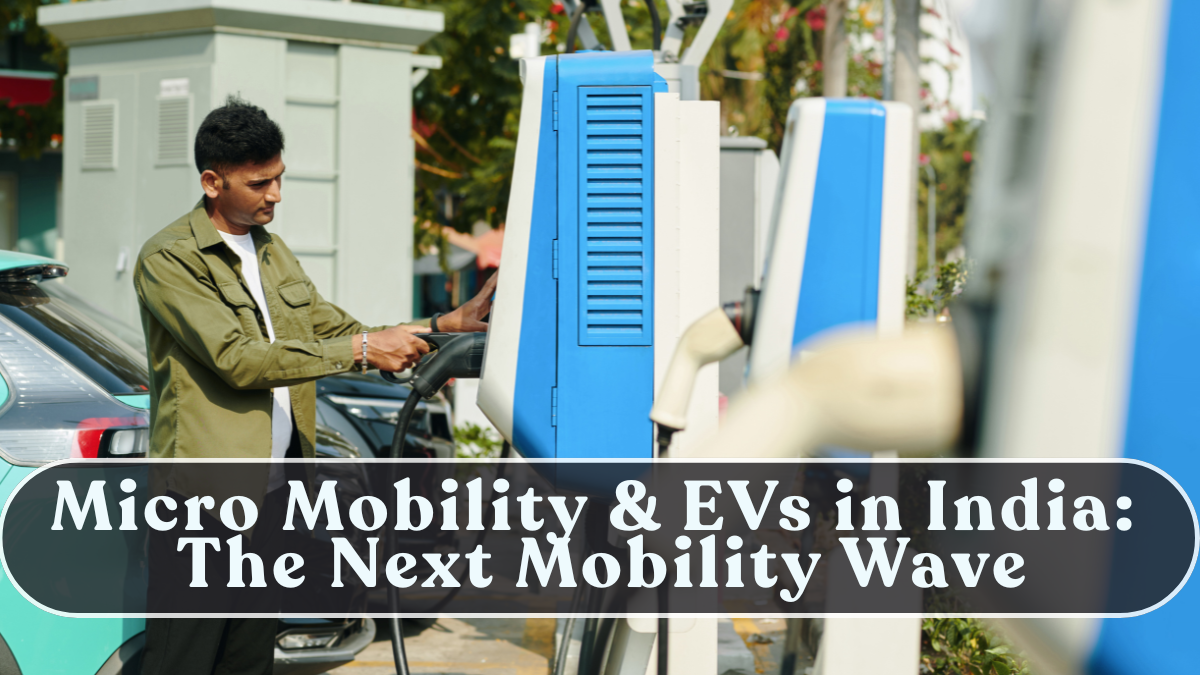India’s mobility landscape is undergoing a silent revolution. Beyond electric cars and scooters, a new player is taking over the streets — micro-mobility EVs. From e-rickshaws to low-speed e-scooters and cargo trikes, these compact electric vehicles are redefining how people and goods move in India’s dense urban spaces.
The rise of micro-mobility EVs in India is not just about convenience — it’s about accessibility, affordability, and sustainability. In cities choked by congestion and pollution, these small electric vehicles represent a smarter, cleaner, and more inclusive mode of transport for millions.

What Are Micro-Mobility EVs?
Micro-mobility EVs refer to light electric vehicles designed for short-distance travel, typically under 10 km. They include:
-
E-rickshaws and E-autos used for shared public transport.
-
Low-speed e-scooters for personal mobility.
-
Electric cargo trikes for last-mile deliveries.
-
Electric bicycles and kick scooters for short urban commutes.
These vehicles usually have a top speed below 45 km/h, require minimal maintenance, and can be charged using standard power outlets — making them ideal for India’s infrastructure and price-sensitive market.
Why Micro-Mobility Is Booming in India
The rapid growth of this segment can be attributed to multiple factors:
-
Affordability: Micro-EVs cost between ₹50,000 and ₹1.5 lakh, far lower than cars or high-speed EVs.
-
Government push: Schemes like FAME II and PM E-Rickshaw Yojana support manufacturing and subsidies.
-
Urban demand: Tier 2 and Tier 3 cities are adopting micro-EVs faster than metros.
-
Rising fuel costs: Electric alternatives offer savings of up to 70% in running costs.
-
Delivery boom: E-commerce and hyperlocal delivery platforms are increasingly turning to electric fleets.
According to NITI Aayog, micro-EVs already account for over 70% of India’s total electric vehicle sales, and this number is expected to grow by 40% annually through 2030.
Role of E-Rickshaws and Last-Mile EVs
E-rickshaws have been the backbone of India’s urban and semi-urban transport revolution. Over 2.4 million registered e-rickshaws operate across the country, carrying passengers on last-mile routes and reducing reliance on diesel-powered autos.
Delivery companies such as Zomato, BigBasket, and Amazon India are also investing in electric cargo bikes and trikes for their urban delivery networks. The benefits are clear — zero tailpipe emissions, low maintenance, and high daily usage capability.
| Type | Example Models | Range (km) | Use Case |
|---|---|---|---|
| E-Rickshaw | Mahindra Treo, YC Electric | 100–130 | Passenger transport |
| Cargo Trike | Euler HiLoad EV, Omega Seiki Rage+ | 80–120 | Goods delivery |
| Micro Scooter | Bounce Infinity, Hero Eddy | 60–85 | Short personal commute |
| E-Bike | EMotorad T-Rex+, Nexzu Roadlark | 40–70 | Urban cycling |
This diverse ecosystem ensures mobility solutions for every income level and need.
Government Initiatives Supporting Micro-EVs
India’s policymakers have recognized micro-mobility as a key pillar of sustainable transport.
-
FAME-II Scheme: Extends subsidies for low-speed EVs and three-wheelers.
-
State EV Policies: States like Delhi, Uttar Pradesh, and Tamil Nadu offer registration fee waivers and road tax exemptions.
-
E-Rickshaw Financing Support: Public sector banks and NBFCs are providing easy loans for electric auto and rickshaw owners.
-
Charging Infrastructure Mission: Aims to install over 700,000 charging points by 2030, including low-voltage units for small EVs.
These combined policies are driving faster adoption and empowering small businesses and self-employed drivers to transition to clean mobility.
Impact on Economy and Environment
Micro-mobility EVs have made significant contributions to India’s green economy:
-
Reduced urban air pollution and noise levels.
-
Created employment opportunities for drivers, mechanics, and battery suppliers.
-
Boosted the domestic EV manufacturing ecosystem with small-scale units producing affordable vehicles and batteries.
-
Enabled logistics cost reduction by up to 30% for delivery-based companies.
Each e-rickshaw or cargo EV replacing a petrol-powered counterpart cuts nearly 4 tonnes of CO₂ emissions per year, showing the massive potential of this segment.
Challenges Facing Micro-Mobility EVs
Despite rapid progress, there are still hurdles to overcome:
-
Battery quality and lifespan concerns in low-cost models.
-
Lack of standardization in vehicle design and safety certification.
-
Limited access to charging in smaller towns.
-
Poor financing options for rural entrepreneurs.
Industry experts believe that with battery swapping, better leasing options, and stronger state-level incentives, the segment can achieve full-scale maturity by 2027.
Future of Micro-Mobility in India
The next stage will focus on smart micro-EVs with IoT-enabled tracking, swappable batteries, and solar-assisted charging. With growing urbanization and increased focus on climate-friendly transport, India’s micro-mobility market is projected to reach $15 billion by 2030.
Private players and startups are also stepping in. Brands like Yulu, Zypp Electric, and SmartE are partnering with metro systems and municipal bodies to expand last-mile connectivity.
Conclusion
The micro-mobility EV boom in India is more than a trend — it’s a mobility revolution for the masses. These compact electric vehicles are solving real-world problems of congestion, pollution, and accessibility while creating jobs and opportunities. With continued policy support and private innovation, micro-mobility is set to become the heartbeat of India’s clean transport future.
FAQs
What are micro-mobility EVs?
Micro-mobility EVs are small, low-speed electric vehicles like e-rickshaws, scooters, and e-bikes used for short-distance travel.
Which cities are leading in micro-EV adoption?
Delhi, Lucknow, Pune, and Bengaluru are among the top cities adopting e-rickshaws and shared EVs.
Are micro-EVs affordable for the average Indian?
Yes, micro-EVs are among the most affordable EVs, costing between ₹50,000 and ₹1.5 lakh.
What are the main challenges for micro-EVs in India?
Battery quality, financing issues, and lack of standardized charging infrastructure remain key challenges.
Will micro-mobility EVs replace petrol scooters and autos?
Gradually yes — especially in cities and towns where last-mile transport and delivery demand are high.
